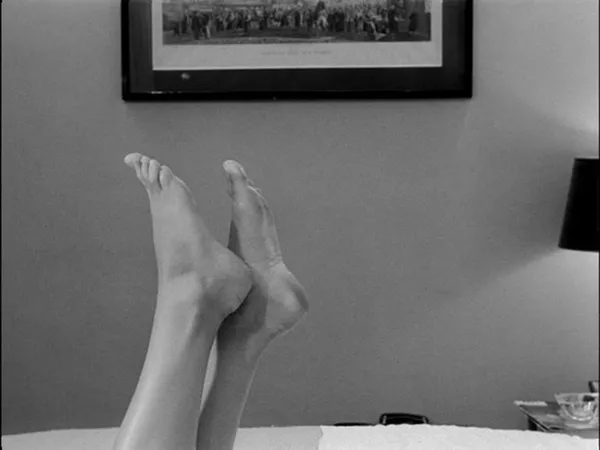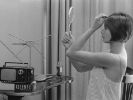Eye For Film >> Movies >> A Married Woman (1964) Film Review
A Married Woman
Reviewed by: Chris

What defines us? Or, what defines anything, for that matter? Is it a dictionary definition or our composite understanding that defines?
A Married Woman (Une Femme Mariée) is perhaps better understood with reference to its original title, The Married Woman. Our opening scene is merely two lovers. A Man. A Woman. Photographed with immaculate perfection, shorn of erotic or personal overtones, each shot encapsulates the beauty and symmetry of an exquisite fashion ad – say, maybe, Chanel. Only after a few moments do we find out who these two individuals – impeccably framed by Raoul Coutard – are in real life. Assuming they are lovers, yes, but we find that Charlotte is a married woman. Her lover is Robert, an actor.

Just as 2 Or 3 Things I Know About Her viewed the world through the eyes of commodification, so does Une Femme Mariée view it through the superficiality of advertising. The usual love triangle of a man and two women is turned on its head by giving Charlotte (Macha Méril) two men between whom she cannot choose. Her aspiration to be perfect is measured in terms of messages sent by Sixties women’s magazines and other media defining the ‘ideal woman’ – whose main aim, it seems, should be to please her husband. Charlotte measures the position of her breasts, listens to a record on how a woman can improve her marriage (it consists of vacuous female laughter), and is expert at seeming light while keeping both men on the back foot. She sees herself as an object of desire for both Robert and husband Pierre and practices superficiality to perfection. She also, however, seems far from dim-witted when giving either of them a grilling.
It is easy to become divided over this film. One can view it as trite, a Godard cast-off, or one can admire the cinematic poetry, the precision with which it delivers its point and its critique of the institution of marriage. It almost goes as far as to suggest that such emptiness is the lot of ‘The Married Woman.’ (The title was changed at the insistence of the censor, who found the definite article disparaging to French women generally. A topless scene was also chopped.) “I love you too, Pierre. Often not the way you believe, but it’s sincere.”
While men’s underwear adverts are just plain photos, adverts for women’s lingerie are accompanied by unrealistic promises of what they will deliver in a woman’s love life (mostly, of course, in terms of a man’s pleasure). At one point, Charlotte is standing next to a gigantic brassiere advert, and it is touchingly clear that society made the image more important than the individual.
Each of our main characters has a monologue, but we additionally hear Charlotte’s internal monologue. When she has had sad thoughts, she repeats to herself, “I’m happy... I’m happy... I’m happy,” as if the mantra will translate into reality. When she learns from the doctor that she is three months pregnant (by whom?), her internal voice tells her, “Find a solution... Save appearances.” She continues to rely quite effectively on the character she has become, now telling each man how much she loves him, all the while skilfully testing him. It is almost as if primitive instinct to secure a hunter-provider takes over. Although Charlotte admits to the doctor she is scared, she doesn’t lose her inner composure even once in the whole movie. She might be shouting, but we can believe it is part of her dexterous womanish wiles – quite ironic, given that she presses Robert to define acting and say exactly how it is different to real life. Only once does she falter, tripping and falling in the road as she leaves the doctor’s surgery. When I look back on a film that is almost devoid of real emotion, it is a heart-rending moment.
Apart from intertitles and jump-cuts to juxtapose intertextual media with narrative, other cinematic tricks include switching between positive and negative photographic images and superimposing summaries. Charlotte eavesdrops on two teenagers as they discuss what a man does during the loss of one’s virginity. Salient point appear in small grey letters over the image (for instance, “Je dors avec un garçon”), perhaps showing how Charlotte reduces everything to its minimalist formula. For those that find the film itself as empty as the subject matter, one need only to look at the extended references to Racine (in Berenice, where Racine similarly makes something out of nothing for a similarly helpless protagonist), or Moliere, who answered critics by saying that, to prevent sin, theatre purifies love.
Perhaps Cahiers critic Jean-Louis Cornolli summed it up best when he described Une Femme Mariée as “a film about a woman’s beauty and the ugliness of her world.” Macha Méril credits it with striking a blow for women’s rights at a time when the pill was still illegal in France.
Reviewed on: 14 May 2012


















